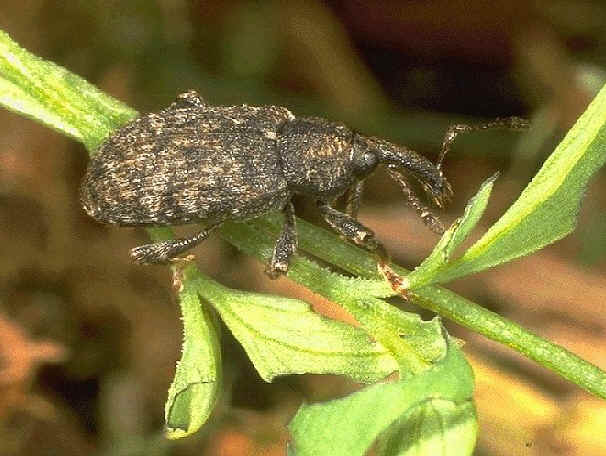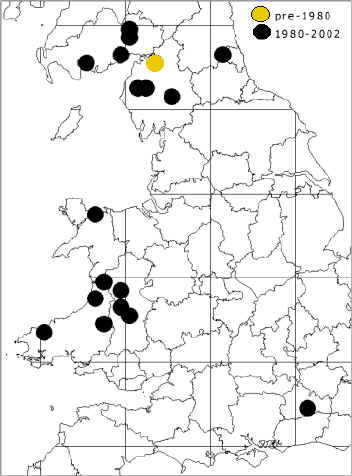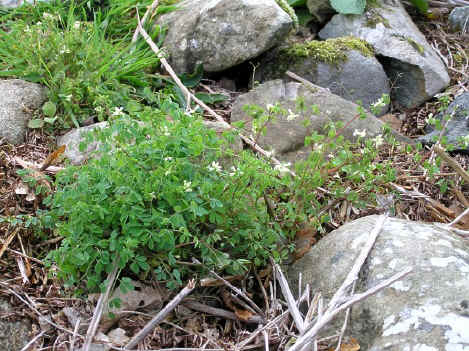
Procas granulicollis Walton, 1848 (Coleoptera, Erirhinidae)

[© R.S.Key]
Identification:
Procas granulicollis is a distinctive, medium-sized weevil that can only really be confused with its congener P. armillatus. Both species are dull black with sparse patches of white setae giving the weevils a slightly mottled appearance. They are both about 5 millimetres long (excluding the rostrum) although individuals vary in size from about 4-7 mm long. Walton (1848) described granulicollis as a new species on the basis of its surface sculpture, but Fowler (1891) dismissed this and relegated granulicollis as a variant of armillatus. Joy (1932) followed this convention and did not provide characters for separation of the two taxa. Kenward (1990) restored granulicollis as distinct and drew attention to the more mottled appearance of granulicollis and microscopic differences in the form of the elytral setae and puncturation, which are clearly illustrated. Any lingering doubts as to the specific identity of granulicollis were dispelled by Richard Thompson's comprehensive review of the genus (Thompson 2006). The genus Procas is included in Morris (2002).
Nomenclature:
Procas granulicollis Walton, 1848
Syn. Procas armillatus (Fabricius) var. granulicollis
World distribution:
Believed to be endemic to Great Britain, where it occurs in scattered localities from southern England to south-western Scotland, Procas granulicollis is now also known to occur in northern Spain (Thompson 2006) and may be expected to inhabit other western European countries.
British distribution:
 Originally
described from a single adult (although it now appears that four specimens were
taken from this locality) collected by T.C. Heysham in Cumberland (Walton, 1848), there were no
more records of this species until Kenward (1990) discovered a single male
further north, in Kirkcudbrightshire, in 1968. Further specimens, originally
identified and reported as P. armillatus, were collected from Cumbria in
1988 (Read, 1989). In 1991 the species was found in Cardiganshire (Fowles
& Boyce, 1992) and subsequent investigations of similar habitats in Wales
have confirmed its presence in Breconshire, Caernarvonshire, Carmarthenshire,
Montgomeryshire, Pembrokeshire and Radnorshire. All of these localities are in western Britain
but in 1992 P. granulicollis was discovered in Co. Durham on the
north-east coast of England and in 1997 it
was unexpectedly found in Surrey (Alexander, 1999). Meanwhile, surveys
in southern Scotland (Godfrey, 1996) found granulicollis present in
five localities in Dumfries and Kirkcudbright and additional localities have
recently been discovered in Cumberland and Westmorland.
Originally
described from a single adult (although it now appears that four specimens were
taken from this locality) collected by T.C. Heysham in Cumberland (Walton, 1848), there were no
more records of this species until Kenward (1990) discovered a single male
further north, in Kirkcudbrightshire, in 1968. Further specimens, originally
identified and reported as P. armillatus, were collected from Cumbria in
1988 (Read, 1989). In 1991 the species was found in Cardiganshire (Fowles
& Boyce, 1992) and subsequent investigations of similar habitats in Wales
have confirmed its presence in Breconshire, Caernarvonshire, Carmarthenshire,
Montgomeryshire, Pembrokeshire and Radnorshire. All of these localities are in western Britain
but in 1992 P. granulicollis was discovered in Co. Durham on the
north-east coast of England and in 1997 it
was unexpectedly found in Surrey (Alexander, 1999). Meanwhile, surveys
in southern Scotland (Godfrey, 1996) found granulicollis present in
five localities in Dumfries and Kirkcudbright and additional localities have
recently been discovered in Cumberland and Westmorland.
To date Procas granulicollis is known from twenty-six localities in 13 vice-counties (VCs 17, 42, 43, 44, 45, 46, 47, 49, 66, 69, 70, 72, 73). It will almost certainly prove to be more widespread and can be expected to be widely distributed, if local, across much of England, Scotland and Wales.
Habitat:
In all cases Procas granulicollis has been found in woodland situations, usually in clearings and often in association with bracken Pteridium aquilinum stands. Most localities are bracken glades in mature deciduous woodland, but it is also known to occur amongst bramble under alder Alnus glutinosa and birch Betula pubescens on a riverbank, underneath mature conifer plantations, and in association with sparse bracken amongst collapsed dry stone walls in wood edge pasture. All sites are either ungrazed or where protection for the adult foodplant, climbing corydalis Ceratocapnos claviculata, is available from bramble thickets or large stones in the form of scree or old walls.
Ecology:
Little is known of
the ecology of this species and the larva is undescribed. Other closely-related members of the
sub-family Erirhininae are known to be endophagous within the roots of a variety of plant species
and it is expected that granulicollis larvae will also feed internally on
plant roots.
 Climbing corydalis is the sole recorded adult foodplant (Fowles,
1992) and it is possible that the larvae are also dependent upon this species as
it occurs in all known granulicollis sites where vegetation composition
has been reported. However, the root system of
corydalis is very flimsy and would appear unlikely to support larvae of the
expected size. Nor have any larvae been found during surveys for the weevil,
despite the fact that corydalis uproots very easily. The only other plant
species that occurs in all reported localities is bracken and it is strongly
suspected that granulicollis larvae must feed within bracken rhizomes.
Further studies are required to confirm this and to elucidate the larval
ecology.
Climbing corydalis is the sole recorded adult foodplant (Fowles,
1992) and it is possible that the larvae are also dependent upon this species as
it occurs in all known granulicollis sites where vegetation composition
has been reported. However, the root system of
corydalis is very flimsy and would appear unlikely to support larvae of the
expected size. Nor have any larvae been found during surveys for the weevil,
despite the fact that corydalis uproots very easily. The only other plant
species that occurs in all reported localities is bracken and it is strongly
suspected that granulicollis larvae must feed within bracken rhizomes.
Further studies are required to confirm this and to elucidate the larval
ecology.
In captivity (Fowles, 1992) adults were predominantly nocturnal, remaining hidden in the bracken litter during the day. However, a single adult has been seen feeding on corydalis in the wild in late afternoon. Adults straddle corydalis leaves and strip away the outer edge of the leaf, leaving a characteristic half-moon hole, before they move on to another leaf. This feeding damage can be conspicuous in occupied localities but similar damage can also be caused by slugs. Stripped leaves should be taken as an indication of the possible presence of Procas granulicollis and litter searched in the vicinity of damaged plants to confirm this supposition.
Typical weevil associates, at least in the Welsh sites, are Sirocalodes mixtus (Mulsant & Rey), which also feeds on Ceratocapnos claviculata, and Barypeithes araneiformis (Schrank).
Phenology:
Adults have been found between March and August and in October, December and January. Timed searches of bracken litter suggest that they are most frequent between late April and the end of June. These data suggest that Procas granulicollis is a summer breeder with the new generation of adults emerging in August and overwintering, although further observations are required to confirm this. The records of this species in winter have been from moss (Walton, 1848), oak leaf litter (Read, 1989), from under bark on a spruce stump (Atty, 1996), and in bracken litter beneath corydalis (Fowles, pers. obs.).
Survey:
Adults are most easily found by sampling bracken litter in the vicinity of climbing corydalis. The litter can either be shaken over a white tray in the field or else brought back for extraction in a Winkler bag (Owen, 1987). The adult weevils frequently remain motionless on the sampling tray and can be difficult to detect amongst the fragments of bracken litter. They are rarely found other than as singletons and the average time taken to find specimens in the field is usually in the order of one adult per half hour of searching. Surveyors should be aware that litter sampling will inevitably result in the uprooting of corydalis plants as their root systems are so flimsy. In localities where corydalis is sparse uprooted plants should be re-planted in situ.
Conservation:
Procas granulicollis is currently classified as Red Data Book (Indeterminate) by the Joint Nature Conservation Committee (Hyman & Parsons, 1992), although the spate of recent discoveries suggests that it should probably be down-graded to Nationally Scarce. It was included on the UK Biodiversity Action Plan list of Priority Species and a Species Action Plan was published in 1999 (UK Biodiversity Group, 1999). This status was awarded on the basis of presumed endemicity and it may be considered that it is no longer worthy of such focus given that it has now been found in continental Europe. As a result Procas granulicollis was not included on the revised list of UKBAP Priority Species published in 2007. However, until such time as its distribution and range are clarified on the continent it is apparent that the UK has an international responsibility to conserve this species.
The objectives of the Species Action Plan are as follows:
(1) Maintain populations at all known sites.
(2) Clarify the taxonomic status of Procas granulicollis.
There is no evidence of decline at known sites supporting this species and it continues to be found at additional localities - at some stage the first objective should be reviewed to reflect increased knowledge of the status of granulicollis in Great Britain. Recent taxonomic studies on the worldwide members of the genus Procas, undertaken by R.T. Thompson at the Natural History Museum, London, have confirmed that granulicollis is a distinct species (Thompson 2006).
At present recommendations for conservation management must be regarded as provisional until details of the larval ecology are confirmed. On the basis that climbing corydalis growing in woodland clearing/wood edge situations appears to be essential for adult feeding at least then measures to maintain populations of this species should provide the foundation for conservation management. Corydalis is very susceptible to grazing and hence livestock should be excluded from localities supporting populations of granulicollis, unless physical barriers (bramble, stones) provide protection for corydalis. Corydalis is an annual which undergoes significant fluctuations in density and may be dependent upon a degree of disturbance to maintain its populations in the medium to long term. Experimental research is required to determine optimal management for corydalis. Whilst corydalis can persist under shade it is most abundant in glades and at the edge of woodlands. Scrub encroachment of occupied glades should be controlled to ensure that open conditions prevail.
References:
Alexander, K.N.A. 1999. Procas granulicollis Walton (Col.: Curculionidae) discovered in Surrey. British Journal of Entomology and Natural History, 12: 220.
Atty, D.B. 1996. Some notable beetles (Coleoptera) in Cumbria. Entomologist's Record and Journal of Variation, 108: 27-36.
Fowler, W.W. 1891. The Coleoptera of the British Islands. 5. London, Reeve.
Fowles, A.P. 1992. Observations on Procas granulicollis Walton (Curculionidae). The Coleopterist, 1: 19-20.
Fowles, A.P. & Boyce, D.C. 1992. Rare and notable beetles from Cardiganshire (VC46) new to Wales. The Coleopterist, 1: 7-15.
Godfrey, A. 1996. Search of sites in SW Scotland for Procas granulicollis. Scottish Natural Heritage, unpublished report.
Hyman, P.S. & Parsons, M.S. 1992. A review of the scarce and threatened Coleoptera of Great Britain. Part 1. UK Nature Conservation. 3. Joint Nature Conservation Committee.
Joy, N.H. 1932. A practical handbook of British beetles. 1 & 2. London, Witherby.
Kenward, H.K. 1990. A belated record of Procas granulicollis Walton (Col., Curculionidae) from Galloway, with a discussion of the British Procas spp. Entomologist's Monthly Magazine, 126: 21-25.
Morris, M.G. 2002. True weevils (Part 1): Coleoptera: Curculionidae (subfamilies Raymondionyminae to Smicronychinae). Handbooks for the Identification of British Insects, 5 (17b).
Owen, J.A. 1987. The 'Winkler extractor'. Proceedings and Transactions of the British Entomological and Natural History Society, 20: 129-132.
Read, R.W.J. 1989. Procas armillatus (F.) (Curculionidae) from Cumbria. Coleopterist's Newsletter, 35: 7.
Thompson, R.T. 2006. A revision of the weevil genus Procas Stephens (Coleoptera: Curculionidae: Erirhinidae). Zootaxa, 1234: 1-63.
UK Biodiversity Group. 1999. Tranche 2 Action Plans. Volume IV - invertebrates. English Nature.
Walton, J. 1848. Notes etc. on the genera of insects Erirhinus, Notaris and Procas; with descriptions of two new species. Ann. Magazine of Natural History, 2: 166-169.
Ward, P.A. 2002. A search for Procas granulicollis at woodland and ffridd sites in Powys. Powys Local Biodiversity Action Plan Partnership, unpublished report.
© A.P. Fowles